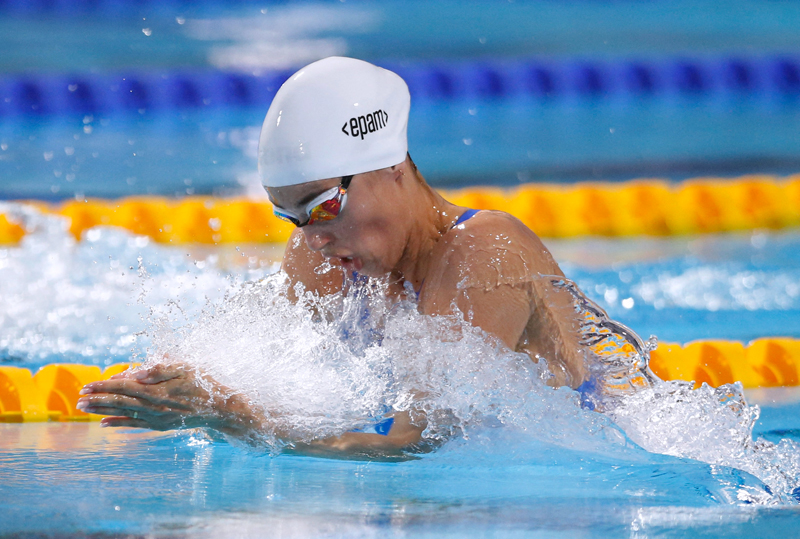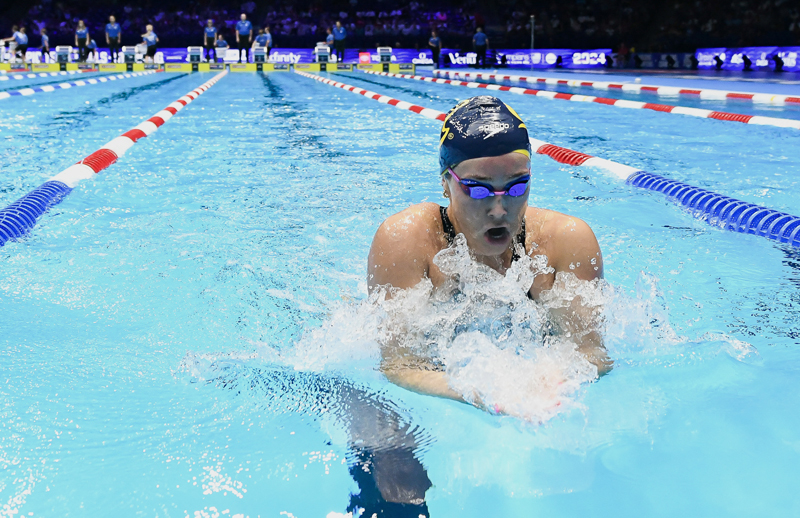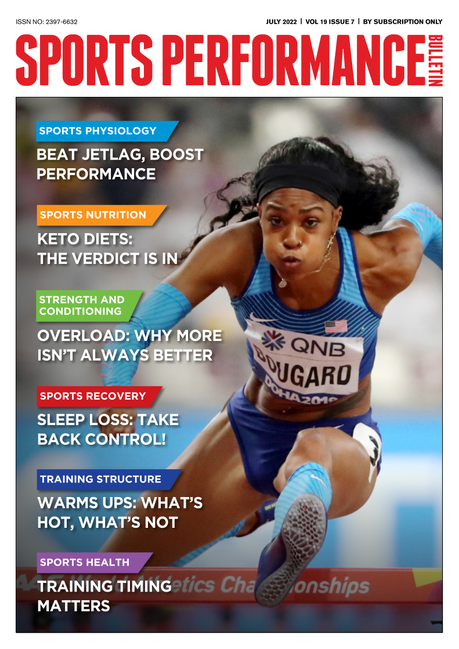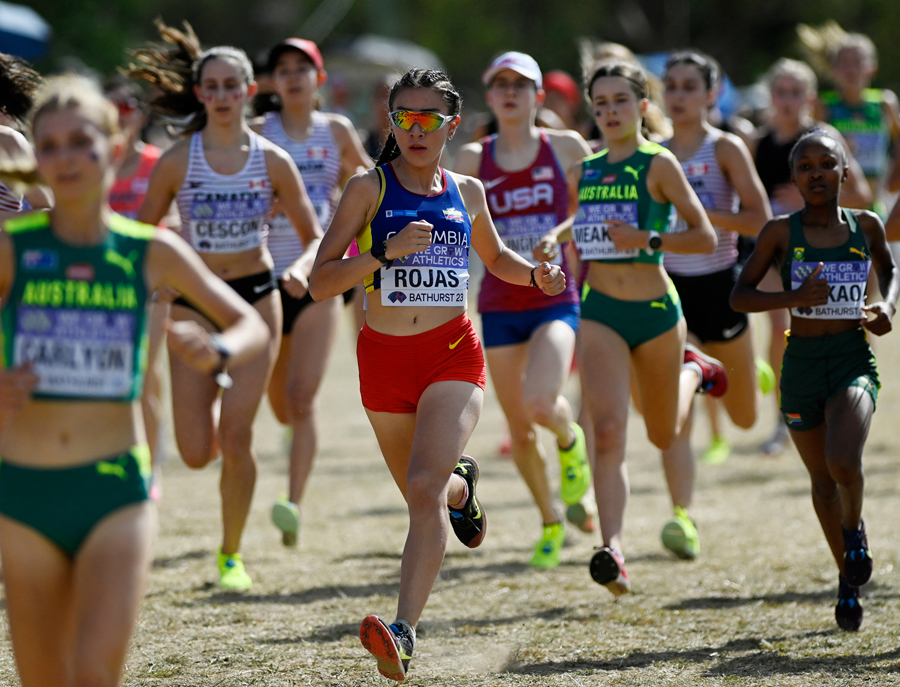You are viewing 1 of your 1 free articles. For unlimited access take a risk-free trial
Breaststroke swimming: not all warm-ups are created equal!
SPB looks at new research on how the type of pre-race warm-up carried out can significantly affect performance in breaststroke and other swimmers
The human body is not a machine that easily can go from rest to full output in an instant, especially when you consider that during hard competition or training, you can be burning anything to 20 times more energy than you use at rest! Without some kind of preparation for this intense work in the form of a warm-up, not only will the body will be put under a large amount physiological stress, there will also be a performance penalty.
This performance penalty arises because muscles that are cold are also more inelastic, increasing the amount of internal friction (and effort) required for muscle movement. They also lack an optimum flow of oxygenated blood, which leads to higher concentrations of muscle-fatiguing lactate if you work them hard without first warming them up. In addition, the joints involved in producing movement are stiffer and require more effort to move through their natural range of movement when cold, thereby making the ligaments supporting these cold joints more prone to damage or tears, resulting in the risk of injury.
Warming up for competition
When it comes to top-level competition over shorter distances, a mere few hundredths of a second may be all that separates the winner from the also-rans. This is especially true in the shorter-distance athletics track and swimming events, where races are completed in less than a minute. Take breaststroke swimming for example; the current world record over the 50-metre distance is just 25.95 seconds, and during the 2022 World Aquatics Championships, the difference between the first and second place in the men’s 50-metre event was only 0.03 seconds(1).
It makes sense therefore that not only are warm-ups essential prior to these events, but also that any warm-up performed is the very best it can be and ideally matched to the demands of the event. In swimming, this is particularly true for breaststroke events, because breaststroke swimming is the least hydrodynamic of the four main strokes, which means swimmers encounter more water resistance for any given speed. This in turn makes improving key performance metrics such as range of motion, speed, and power in breaststroke absolutely crucial for enhancing competitive performance.
General warm-up principles
As we’ve explored in previous SPB articles, the old-fashioned approach to warming up involving a pulse raiser and some static stretches has long fallen out of favor. Instead, dynamic warm-ups emphasizing range of motion, speed and neuromuscular recruitment are most commonly used to enhance performance. Unlike static stretching, dynamic warm-ups can increase the range of motion of limbs without negatively affecting maximum strength and explosiveness(2). Although they vary according to the event being prepared for, a dynamic warm-up typically consists of three components:
1. An aerobic phase, comprising of sport-specific actions (ie jogging for running sport, swimming for swimmers etc) combined with mobility exercises as well as dynamic stretching focused on the relevant limbs. A key purpose here is to raise the pulse and core temperature, and put the limbs through their full range of motion(3).
2. A neuromuscular phase, which might include including resistance/loading exercises and/or balance exercises. This is to activate maximum muscle recruitment and motor skills(4,5).
3. A velocity phase comprising of sprints and over several distances – to help ensure all systems are primed for maximum speed and effort(6).
Swimming-specific warm-ups
While the broad principles of warm-ups apply equally to swimmers, unlike other athletes, swimmers have to perform in the water, which is a very different environment to land, and where gravity has a minimal impact but resistance of the (water) medium has a disproportionate impact. Therefore, many swimming coaches recommend swimming with hand paddles for sprints during warm-ups. These paddles provide extra resistance (satisfying element #2 above) yet are sport specific, loading the muscles and providing neurological stimulation in the same way that is needed during competition.
Some swimming coaches however recommend that performing weighted warm-ups on land can also provide a neurological and muscular stimulus to enhance performance during competition. This approach is analogous to land athletes engaging in sled sprints, using weighted bats or performing squats as part of a pre-competition warm up(7,8). Other coaches believe that a land warm-up simulating the swimming stroke but with reduced resistance - for example by the use of resistance tubes or bands – is effective because it loads the swimming muscles but allows the swimmer to achieve faster movement speeds or higher stroke frequencies during warm-ups. This (in theory) translates to ‘neurologically faster activation’ in the water, providing a performance advantage – in a similar way that assisted jumps in land-based sports allow athletes to move with less resistance and increasing their movement speed (also known as ‘overspeed training’)(9).
New breaststroke warm-up research
Given the special demands of breaststroke swimming, any warm-up method that can enhance performance should be embraced. But while these various methods (hand paddles, deep squats, tubing-assisted exercises) are all popular, there’s actually very little research comparing their effectiveness on the bottom line – competition performance in breaststroke and individual medley swimmers! However, the answer to the question as to which warm-up method is best seems to be solved thanks to brand new research by a team of Taiwanese scientists(10).
In this study, which was published in the journal ‘Frontiers in Bioengineering and Biotechnology’, 18 swimmers who met the swimming competition standards of the National Intercollegiate Athletic Games were recruited. Nine were breaststroke specialists and nine were individual medley swimmers (where freestyle, backstroke, breaststroke and butterfly are combined into one race). To ensure all the participants could quickly familiarize themselves with the tests, all participants were required to have been swimming training for four years or more, with at least one year of coached strength training experience.
What they did
On four separate occasions each separated by a week, the participants completed four types of warm-up protocols each of which was followed by a 50-metre performance time trial. These warm-ups were as follows:
- Conventional 1,400m warm-up – consisting of 400m of swimming using a stroke and pace of choice; 200m of pulling exercises; 200m of kicking exercises using fins; four sets of 100m, alternating between two pulling exercises and two individual medleys; 100m of simple swimming; two sets of 50m consisting of diving and swimming with a pace of 15 m fast/35 m easy.
- Tubing assisted warm-up – consisting of a 700m conventional warm-up (a shortened version of the above) plus two tubing-assisted 20-metre sprints, with a 2-minute rest between each. During this tubing-assisted warm-up, one end of a tube (a StrechCordz resistance band) was secured to the swimmer’s waist, while the other end was pulled by a researcher standing at the finish line reeling in the swimmer as quickly as possible during the swimmer’s upper limb pull phase and lower limb kick phase (see figure 1A). The purpose was to ‘speed up’ the neurological input to muscles, in readiness for the 50m time trial that followed.
- Paddle warm-up – consisting of a 700m conventional warm-up as above then two 20m sprints with a 2-minute rest between each sprint (Figure 1B). These sprints were performed using swim paddles (Strokemakers Technique Swimming Paddles) - designed to be slightly larger than the palms of the swimmers’ hands.
- Squat warm-up – consisting of a 700m conventional warm-up as above then two sets of 3 x repetitions of barbell back squat at 85% of 1-rep max, with a 2-minute rest between sets (figure 1C).
On the first trial, all participants performed the conventional 1,400m warm-up swimming test, but to ensure no systematic bias crept in, they completed the remaining warm-up swimming protocols according to a counterbalanced design: the first participant in each group followed the order tubing, paddle, and squat; the second participant followed the order paddle, squat, and tubing; the third participant used the sequence squat, tubing, and paddles and so on. During the 50m breaststroke performance test, video analysis was used to evaluate and compare stroke performance, stroke length, stroke frequency, and the acceleration of the hands, pelvis, and feet across the different warm-up methods.
Figure 1: Tubing paddle and squat warm-ups following the 700m swim

What they found
When all the performance data was collated and analyzed, the key finding was that when the breaststroke specialists performed the 700m swim plus tubing-assisted warm-ups, they swam significantly faster in the 50-metre time trial than when they performed the conventional 1,400-metre warm-ups (35.31 seconds for tubing vs. 35.67 for conventional). However, the 700m swim plus paddle and 700m swim plus squat warm ups did not significantly improve the breaststroke specialists’ performances. Another finding was that for the individual medley swimmers, performing a ‘700m swim plus squats’ warm-up improved 50-metre swim times compared to the 700m swim/paddle warm up (34.52 seconds vs. 34.92 seconds).
When the researchers analyzed the movement patterns of the swimmers using the video footage, they also noticed that the stroke length of breaststroke specialists following the tubing-assisted warm-ups was shorter than that following the paddle warm-ups, the squat warm-ups, and the conventional 1,400m warm-ups. However, they also observed that the stroke frequency (strokes per minute) was higher with the tube-assisted warm-ups – an observation that explains why their times were faster despite the shorter stroke length. Curiously though, the performance improvements that were observed above didn’t seem to correlate with acceleration data, which implies that rather than force gains, it was improved technique that was driving the improvements.
Practical implications for swimmers
Swimmers who swim breaststroke only will be training for intensively and specifically for this stroke, with the aim of increased mastery, strength control, frequency, and efficiency in breaststroke execution. By contrast, individual medley swimmers, who primarily compete in 200-metre events (50 metres per leg for each of the four strokes) have to be better all-rounders. Following a turn at the end of the backstroke leg and push off the wall, they will often adopt a gliding strategy to conserve energy during the start of the 50-metre breaststroke leg.
This difference results in variations of stroke frequency and movement control between the groups, which in turn suggests breaststroke and individual medley swimmers should employ different warm-ups. If you are a breaststroke specialist swimmer, a warm up that encourages fast or ‘overspeed’ activation to increase stroke frequency – for example by performing tube-assisted sprints – is recommended over other warm-up protocols. By contrast, for individual medley swimmers, warm-ups that incorporate squats are recommended. The optimum combination of sets and reps are yet to be determined, but in the above study, two sets of 3 x reps at 85% of 1-rep max seemed to work well.
But what about other swimmers – for example freestyle swimmers and triathletes? In the study above, the authors pointed out that the upper body arm ‘pull’ is proportionately greater in breaststroke than in the other strokes. That’s why speeding it up helped the breaststroke specialists but had little benefit on the individual medley swimmers. Instead, they benefited most from squats after their in-water 700m warm-up. Applying this logic to freestyle swimming, we might expect that including squats would be preferable to tube-assisted sprints. Indeed, a 2022 review study looked at the data on a variety of warm up approaches for freestyle swimmers over various distances; it concluded that for event of 400m length or less, performing high load resistance exercises such as squats was indeed a very efficient way of increasing activation and improving performance(11). It also concluded that the in-water warm-up distance should ideally be around 600m, and that regardless of type, some kind ballistic or loading exercise produces better race performance than just a swimming-only warm-up!
References
1. www.fina.org
2. Appl. Physiol. Nutr. Metab 2016. 41 (1), 1–11
3. Sports Med 2003. 33 (6), 439–454
4. Sports Med 2014. 44 (3), 319–330
5. J. Strength Cond. Res 2021. 35 (5), 1357–1363
6. Sports Med. 2018 Oct;48(10):2285-2299
7. J. Sci. Med. Sport 2017. 20 (8), 781–785
8. J. Strength Cond. Res 2013. 27 (11), 2997–3000
9. J. Sci. Med. Sport 2011. 14 (1), 85–89
10. Front Bioeng Biotechnol. 2025 Jan 7;12:1505648
11. Sports Med Open. 2022 Sep 24;8:120
Newsletter Sign Up
Testimonials
Dr. Alexandra Fandetti-Robin, Back & Body Chiropractic
Elspeth Cowell MSCh DpodM SRCh HCPC reg
William Hunter, Nuffield Health
Newsletter Sign Up
Coaches Testimonials
Dr. Alexandra Fandetti-Robin, Back & Body Chiropractic
Elspeth Cowell MSCh DpodM SRCh HCPC reg
William Hunter, Nuffield Health
Keep up with latest sports science research and apply it to maximize performance
Today you have the chance to join a group of athletes, and sports coaches/trainers who all have something special in common...
They use the latest research to improve performance for themselves and their clients - both athletes and sports teams - with help from global specialists in the fields of sports science, sports medicine and sports psychology.
They do this by reading Sports Performance Bulletin, an easy-to-digest but serious-minded journal dedicated to high performance sports. SPB offers a wealth of information and insight into the latest research, in an easily-accessible and understood format, along with a wealth of practical recommendations.
*includes 3 coaching manuals
Get Inspired
All the latest techniques and approaches
Sports Performance Bulletin helps dedicated endurance athletes improve their performance. Sense-checking the latest sports science research, and sourcing evidence and case studies to support findings, Sports Performance Bulletin turns proven insights into easily digestible practical advice. Supporting athletes, coaches and professionals who wish to ensure their guidance and programmes are kept right up to date and based on credible science.











